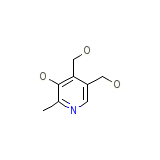Hexobion




Hexobion Brand names, Hexobion Analogs
- Adermin hydrochloride
- Adermine hydrochloride
- Aderomine hydrochloride
- Aderoxine
- Alestrol
- Becilan
- Beesix
- Benadon
- Bonasanit
- Campoviton 6
- Gravidox
- Hexa-Betalin
- Hexabione hydrochloride
- Hexavibex
- Hexermin
- Hexermine
- Hexobion
- Hydoxin
- Nestrex
- Pydox
- Pyridipca
- Pyridox
- Pyridoxal
- Pyridoxamine
- Pyridoxin hydrochloride
- Pyridoxine Chloride
- Pyridoxine HCl
- Pyridoxine hydrochloride
- Pyridoxine hydrogen chloride
- Pyridoxine-HCl Microencapsulated
- Pyridoxinium Chloride
- Pyridoxinum Hydrochloricum
- Pyridoxol hydrochloride
- Rodex TD
- Tex Six T.R.
- Vitamin B
- Vitamin B6 hydrochloride
Hexobion Brand Names Mixture
- No information avaliable
Hexobion Chemical_Formula
C8H11NO3
Hexobion RX_link
No information avaliable
Hexobion fda sheet
Hexobion msds (material safety sheet)
Hexobion Synthesis Reference
No information avaliable
Hexobion Molecular Weight
169.178 g/mol
Hexobion Melting Point
207 oC
Hexobion H2O Solubility
2.2E+005 mg/L
Hexobion State
Solid
Hexobion LogP
-0.784
Hexobion Dosage Forms
Capsules
Hexobion Indication
For the treatment of vitamin B6 deficiency and for the prophylaxis of isoniazid-induced peripheral neuropathy.
Hexobion Pharmacology
Vitamin B6 (pyridoxine) is a water-soluble vitamin used in the prophylaxis and treatment of vitamin B6 deficiency and peripheral neuropathy in those receiving isoniazid (isonicotinic acid hydrazide, INH). Vitamin B6 has been found to lower systolic and diastolic blood pressure in a small group of subjects with essential hypertension. Hypertension is another risk factor for atherosclerosis and coronary heart disease. Another study showed pyridoxine hydrochloride to inhibit ADP- or epinephrine-induced platelet aggregation and to lower total cholesterol levels and increase HDL-cholesterol levels, again in a small group of subjects. Vitamin B6, in the form of pyridoxal 5'-phosphate, was found to protect vascular endothelial cells in culture from injury by activated platelets. Endothelial injury and dysfunction are critical initiating events in the pathogenesis of atherosclerosis. Human studies have demonstrated that vitamin B6 deficiency affects cellular and humoral responses of the immune system. Vitamin B6 deficiency results in altered lymphocyte differentiation and maturation, reduced delayed-type hypersensitivity (DTH) responses, impaired antibody production, decreased lymphocyte proliferation and decreased interleukin (IL)-2 production, among other immunologic activities.
Hexobion Absorption
Readily absorbed
Hexobion side effects and Toxicity
Oral Rat LD50 = 4 gm/kg. Toxic effects include convulsions, dyspnea, hypermotility, diarrhea, ataxia and muscle weakness.
Hexobion Patient Information
No information avaliable
Hexobion Organisms Affected
Humans and other mammals














